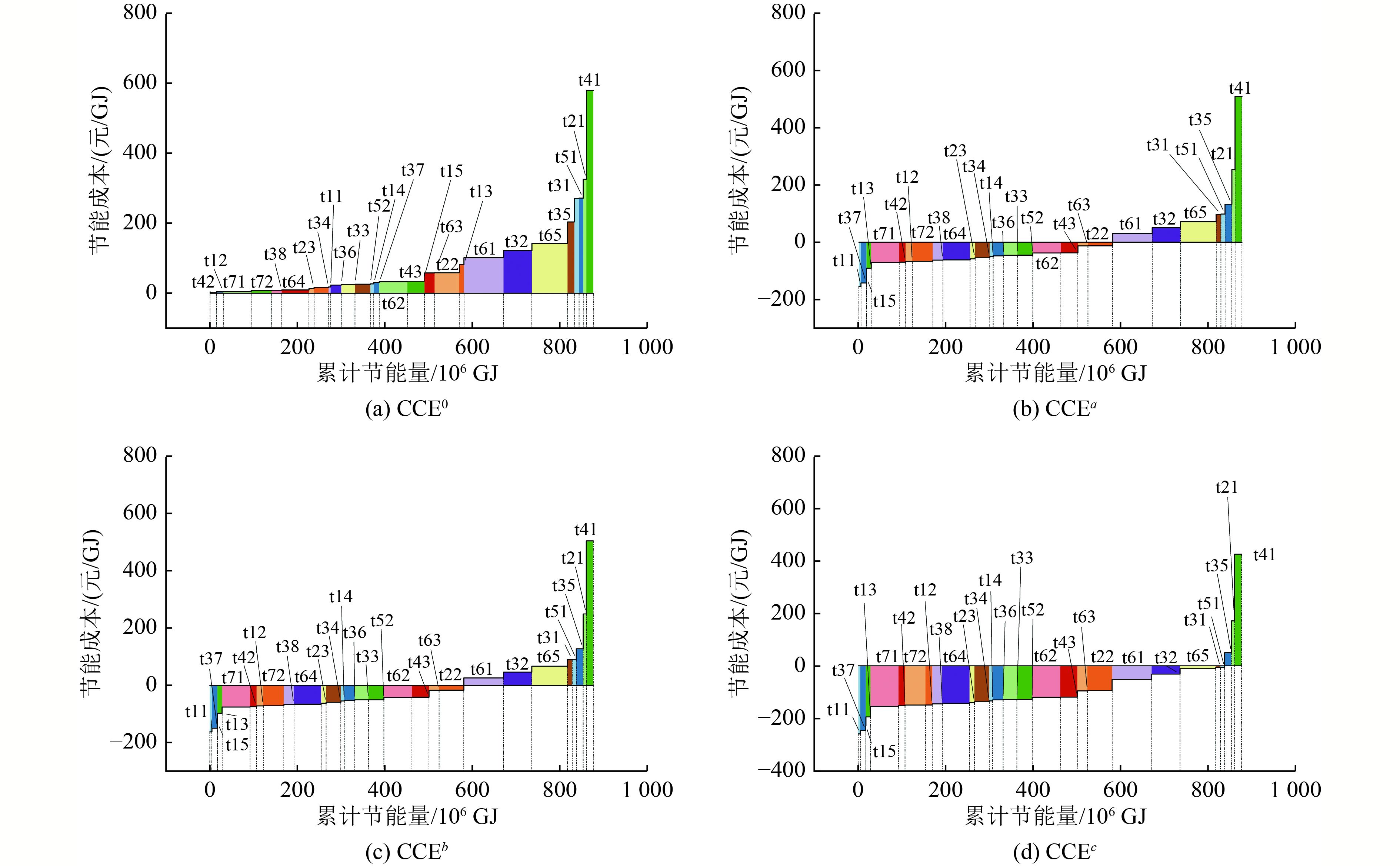Analysis of cost and potential of energy-conservation technologies in iron and steel industry: a case study of the Yangtze River Delta region
-
摘要:
钢铁行业是能源消耗和碳排放的重点行业,节能减排是钢铁行业绿色低碳转型发展的有效途径,节能技术是钢铁行业提高能源效率、降低碳排放和减少空气污染的关键。运用节能供给曲线方法对长三角地区钢铁行业技术节能成本进行评价,并对2030年长三角地区钢铁行业技术节能潜力进行评估。结果表明:钢铁行业28项技术在2030年预计为长三角地区累计节能875.74 PJ,约为2020年长三角地区钢铁行业总能耗的34%;考虑不同收益项时的技术节能成本存在差异,当不考虑任何收益时技术的节能成本最高,当将协同效益纳入考虑后,技术的节能成本降到较低水平;贴现率、温室气体或污染物交易价格等因素会对技术的节能成本产生影响,贴现率越高意味着资金成本越高,技术的节能成本也相应越高;温室气体或污染物价格上升会增加技术节能的收益,从而降低技术的节能成本。
Abstract:As a typical resource and energy intensive industry, energy saving and emission reduction is the effective green and low-carbon transformation and development path of the iron and steel industry. Energy-conservation technologies are vital to improve energy efficiency, reduce carbon emissions and decrease air pollution in the iron and steel industry. The Conservation Supply Curve method was used to evaluate the techonolies’ energy-conservation cost of the iron and steel industry in the Yangtze River Delta region. And the energy conservation potential realized by the technologies in the region in 2030 was evaluated. The results showed that 28 energy-conservation technologies in the iron and steel industry were expected to save 875.74 PJ of energy in 2030, which was about 34% of the total energy consumption of the iron and steel industry in the Yangtze River Delta in 2020. When different income items were considered, the energy-conservation cost of technologies was different; when no income was considered, the energy-conservation cost of technologies was the highest; when the co-benefit was taken into account, the energy-conservation cost was reduced to a lower level. The discount rate, the trading price of greenhouse gases or pollutants and other factors would have an impact on the energy-conservation cost of the technologies. The higher the discount rate, the higher the capital cost, and the higher the energy-conservation cost of the technologies. A rise in the price of greenhouse gases or pollutants would increase the benefit of energy conservation and thus reduce the cost of energy conservation of the technologies.
-
Key words:
- iron and steel industry /
- energy conservation cost /
- emissions reduction /
- co-benefit
-
表 1 情景设置
Table 1. Different scenarios settings
情景 电炉钢比/% 技术普及 粗钢产量 BAU 10 保持2020年水平 2020年产量 PAS 30 保持2020年水平 2030年预测产量 TPS 10 考虑技术普及 2030年预测产量 CSS 30 考虑技术普及 2030年预测产量 表 2 中国钢铁行业中间产品量及原料对应单位粗钢产品折算系数
Table 2. Conversion coefficients of the intermediate products and raw materials corresponding to crude steel in China's iron and steel industry
单位产品 折算系数 焦炭 0.33 烧结矿 1.35 生铁 0.92 粗钢 1 钢材 1.32 表 3 节能技术基本信息数据来源
Table 3. Sources of energy-conservation technologies basic information
工序 序号 技术名称 数据来源 烧结 t11 转臂式液密封环冷机 文献[30] t12 厚料层烧结技术 文献[10,32] t13 烧结余热发电 文献[26] t14 烧结烟气内循环技术 文献[27,29] t15 减污折叠滤筒节能技术 文献[31] 焦化 t21 煤调湿技术(CMC) 文献[33] t22 干熄焦技术(CDQ) 文献[33] t23 焦炉上升管余热回收技术 文献[27-29] 高炉炼铁 t31 高炉煤气干式余压发电技术(TRT) 文献[33] t32 高炉煤粉喷吹技术 文献[33] t33 热风炉烟气余热回热器 文献[2,11] t34 高炉自动化控制技术 文献[2,11] t35 燃气蒸汽联合循环发电技术(CCPP) 文献[26] t36 旋切式高风温顶燃热风技术 文献[26] t37 高炉喷吹废塑料技术 文献[2,11] t38 高炉鼓风除湿节能技术 文献[26] 转炉炼钢 t41 转炉烟气余热回收技术 文献[10-11] t42 钢水真空循环脱气工艺干式(机械)
真空系统应用技术文献[26] t43 转炉烟气干法除尘技术 文献[2,11] 电炉炼钢 t51 废钢预热连续加料技术 文献[30] t52 电炉烟气余热回收技术 文献[33] 轧钢 t61 热装热送技术 文献[2,11] t62 热轧过程控制模型关键技术 文献[11,32] t63 加热炉黑体强化辐射节能技术 文献[26] t64 加热炉蓄热式燃烧技术 文献[2] t65 连续退火技术 文献[10,32] 综合性技术 t71 预防性维护技术 文献[10-11] t72 能源监测与管理系统 文献[33] 表 4 节能技术扩散渗透参数与预计普及率
Table 4. Penetration parameters and estimated popularity rates of the energy-conservation technologies
技术序号 渗透参数(S) 2022年普及率/% 2030年普及率/% t11 1.70 20 100 t12 5.59 90 100 t13 5.16 50 97 t14 6.84 2 66 t15 2.65 5 70 t21 8.29 45 90 t22 3.09 95 100 t23 7.05 10 85 t31 7.45 55 95 t32 3.55 90 100 t33 5.79 75 100 t34 4.56 85 100 t35 5.22 40 65 t36 3.69 80 100 t37 7.51 45 75 t38 5.22 40 96 t41 5.40 70 99 t42 11.45 10 48 t43 5.71 70 90 t51 17.96 20 55 t52 3.99 85 100 t61 9.47 65 88 t62 5.59 90 100 t63 8.02 30 77 t64 3.70 85 100 t65 4.20 80 100 t71 1.58 99 100 t72 3.70 90 100 表 5 二氧化碳及主要大气污染物排放因子
Table 5. Emission factors of carbon dioxide and several main air pollutants
kg/GJ 排放物 燃料燃烧排放因子 电力使用排放因子 CO2 104.40 158.42 SO2 0.655 80 0.7339 NOx 0.25 0.346 6 PM10 1.549 3 1.941 3 表 6 二氧化碳及主要大气污染物价格/货币化价值
Table 6. Prices or monetized value of carbon dioxide and several main air pollutants
元/t 排放物 价格/货币化价值 CO2 42.85 SO2 5 505 NOx 6 137 PM10 47 098 表 7 2030年28项节能技术的节能潜力与减排效果
Table 7. Energy conservation potential and emission reduction effect of 28 technologies in 2030
技术序号 总节能量/PJ 减排量/万t CO2 SO2 NOx PM10 t11 4.76 75.35 0.35 0.16 0.92 t12 15.34 160.18 1.01 0.38 2.38 t13 10.72 169.76 0.79 0.37 2.08 t14 7.86 84.57 0.52 0.20 1.24 t15 0.24 3.81 0.02 0.01 0.05 t21 7.09 74.00 0.46 0.18 1.10 t22 56.26 587.33 3.69 1.41 8.72 t23 11.43 119.92 0.75 0.29 1.78 t31 10.73 169.95 0.79 0.37 2.08 t32 64.83 676.79 4.25 1.62 10.04 t33 31.37 327.48 2.06 0.78 4.86 t34 33.46 349.31 2.19 0.84 5.18 t35 15.63 163.19 1.03 0.39 2.42 t36 24.05 251.07 1.58 0.60 3.73 t37 12.55 198.77 0.92 0.43 2.44 t38 23.09 241.03 1.51 0.58 3.58 t41 15.75 164.45 1.03 0.39 2.44 t42 14.73 153.77 0.97 0.37 2.28 t43 38.87 405.79 2.55 0.97 6.02 t51 9.64 152.78 0.71 0.33 1.87 t52 35.07 366.13 2.30 0.88 5.43 t61 90.53 945.10 5.94 2.26 14.03 t62 64.29 671.24 4.22 1.61 9.96 t63 23.10 241.20 1.52 0.58 3.58 t64 62.15 648.86 4.08 1.55 9.63 t65 81.44 850.23 5.34 2.04 12.62 t71 63.90 682.48 4.21 1.62 10.01 t72 46.86 496.91 3.08 1.19 7.32 总计 875.74 9431.47 57.85 22.41 137.77 表 8 各项技术的单位节能成本
Table 8. Unit energy-conservation costs of technologies
元/GJ 技术序号 普通成本 考虑
节能收益考虑碳减排的
协同效益考虑大气污染物
减排的协同效益技术序号 普通成本 考虑
节能收益考虑碳减排的
协同效益考虑大气污染物
减排的协同效益t11 17.98 −154.80 −161.58 −259.18 t37 30.45 −142.33 −149.12 −246.72 t12 3.92 −66.65 −71.12 −149.24 t38 8.20 −62.37 −66.85 −144.96 t13 82.20 −90.58 −97.37 −194.97 t41 579.43 508.86 504.38 426.27 t14 26.84 −49.80 −54.51 −133.68 t42 1.39 −69.18 −73.65 −151.77 t15 48.68 −124.10 −130.89 −228.49 t43 34.13 −36.44 −40.91 −119.02 t21 324.47 253.90 249.43 171.32 t51 271.08 98.30 91.51 −6.08 t22 58.41 −12.16 −16.64 −94.75 t52 25.35 −45.22 −49.69 −127.81 t23 13.61 −57.86 −62.36 −140.64 t61 101.40 30.83 26.35 −51.76 t31 270.39 97.61 90.83 −6.77 t62 33.06 −37.51 −41.98 −120.09 t32 121.72 51.25 46.68 −31.43 t63 57.92 −12.65 −17.12 −95.23 t33 25.28 −45.29 −49.77 −127.88 t64 9.30 −61.27 −65.75 −143.86 t34 16.26 −54.31 −58.78 −136.90 t65 142.30 71.73 67.25 −10.86 t35 203.15 132.58 128.10 49.99 t71 4.42 −70.69 −75.27 −154.24 t36 23.14 −47.43 −51.91 −130.02 t72 7.32 −66.35 −70.90 −149.60 -
[1] 冶金工业规划研究院. 中国钢铁工业节能低碳发展报告(2020)[EB/OL]. (2020-12-24)[2022-12-07]. http://www.mpi1972.com/xwzx/yndt/202012/t20201224_94730.html. [2] 任明, 徐向阳.京津冀地区钢铁行业节能潜力及成本分析[J]. 生态经济,2018,34(10):91-97.REN M, XU X Y. Cost and energy saving potential of iron and steel industry in Jing-Jin-Ji Region[J]. Ecological Economy,2018,34(10):91-97. [3] 国家发展和改革委员会. 关于严格能效约束推动重点领域节能降碳的若干意见[A/OL]. (2021-10-18)[2022-12-07]. https://www.ndrc.gov.cn/xxgk/zcfb/tz/202110/t20211021_1300583.html?code=&state=123. [4] 工业和信息化部. 关于印发工业能效提升行动计划的通知[A/OL]. (2022-06-29)[2022-12-07]. https://www.miit.gov.cn/jgsj/jns/nyjy/art/2022/art_c43d89e0b209438bad7f7baa28606273.html. [5] 工业和信息化部. 关于促进钢铁工业高质量发展的指导意见[A/OL]. (2022-05-20)[2022-12-07]. https://www.ndrc.gov.cn/xwdt/ztzl/cjgyjjpwzz/bmgzqk/202205/t20220520_1324965.html?code=&state=123. [6] 易文杰, 李庄, 罗竹燕, 等.水泥行业环境影响评价低碳技术选择与应用[J]. 环境工程技术学报,2022,12(6):1905-1914. doi: 10.12153/j.issn.1674-991X.20220590YI W J, LI Z, LUO Z Y, et al. Selection and application of low carbon technologies in environmental impact assessment of cement industry[J]. Journal of Environmental Engineering Technology,2022,12(6):1905-1914. doi: 10.12153/j.issn.1674-991X.20220590 [7] 李庄, 许友静, 易文杰, 等.钢铁企业低碳技术评价选择与应用[J]. 环境科学研究,2022,35(6):1538-1546.LI Z, XU Y J, YI W J, et al. Evaluation, selection and application of low-carbon technology in iron and steel enterprises[J]. Research of Environmental Sciences,2022,35(6):1538-1546. [8] MEIER A K. Supply curves of conserved energy[D]. Berkeley: University of Berkeley, 1982. [9] WORRELL E, PRICE L, MARTIN N. Energy efficiency and carbon dioxide emissions reduction opportunities in the US iron and steel sector[J]. Energy, 2001, 26(5): 513-536. [10] ZHANG Q, ZHAO X Y, LU H Y, et al. Waste energy recovery and energy efficiency improvement in China's iron and steel industry[J]. Applied Energy, 2017, 191:502-520. [11] LI Y, ZHU L. Cost of energy saving and CO2 emissions reduction in China's iron and steel sector[J]. Applied Energy,2014,130:603-616. doi: 10.1016/j.apenergy.2014.04.014 [12] 毛显强, 曾桉, 刘胜强, 等.钢铁行业技术减排措施硫、氮、碳协同控制效应评价研究[J]. 环境科学学报,2012,32(5):1253-1260.MAO X Q, ZENG A, LIU S Q, et al. Assessment of SO2, NOx and CO2 co-control effects by technological reduction measures in iron & steel industry[J]. Acta Scientiae Circumstantiae,2012,32(5):1253-1260. [13] 刘胜强, 毛显强, 胡涛, 等.中国钢铁行业大气污染与温室气体协同控制路径研究[J]. 环境科学与技术,2012,35(7):168-174. doi: 10.3969/j.issn.1003-6504.2012.07.037LIU S Q, MAO X Q, HU T, et al. Roadmap of Co-control of air pollutants and GHGs in iron and steel industry in China[J]. Environmental Science & Technology,2012,35(7):168-174. doi: 10.3969/j.issn.1003-6504.2012.07.037 [14] 马丁, 陈文颖.中国钢铁行业技术减排的协同效益分析[J]. 中国环境科学,2015,35(1):298-303.MA D, CHEN W Y. Analysis of the co-benefit of emission reduction measures in China's iron and steel industry[J]. China Environmental Science,2015,35(1):298-303. [15] 许立松, 张琦.中国重点区域钢铁产业能耗和CO2排放趋势分析[J]. 中国冶金,2021,31(9):36-45.XU L S, ZHANG Q. Analysis on energy consumption and CO2 emission trend of China's iron and steel industry in key regions[J]. China Metallurgy,2021,31(9):36-45. [16] 李小敏, 许亚宣, 于华通. 长三角地区钢铁行业发展现状[C]//2017中国环境科学学会科学与技术年会论文集(第一卷). 厦门, 2017: 210-218. [17] 国家统计局. 年度数据[DB/OL]. [2022-12-07]. https://data.stats.gov.cn/. [18] 工业和信息化部. 钢铁产能置换办法[EB/OL]. (2021-04-17)[2022-12-07]. http://www.gov.cn/zhengce/zhengceku/2021-05/07/content_5605092.html. [19] LIU X W, YUAN Z W, XU Y, et al. Greening cement in China: a cost-effective roadmap[J]. Applied Energy,2017,189:233-244. doi: 10.1016/j.apenergy.2016.12.057 [20] 郑佳佳, 孙星, 张牧吟, 等.温室气体减排与大气污染控制的协同效应: 国内外研究综述[J]. 生态经济,2015,31(11):133-137. doi: 10.3969/j.issn.1671-4407.2015.11.030ZHENG J J, SUN X, ZHANG M Y, et al. Review of researches on the synergistic effect of GHGs mitigation and air pollution control at home and abroad[J]. Ecological Economy,2015,31(11):133-137. doi: 10.3969/j.issn.1671-4407.2015.11.030 [21] 浙江省经济和信息化厅. 浙江省钢铁行业产能置换实施细则(征求意见稿)[EB/OL]. [2020-10-20]. http://jxt.zj.gov.cn/art/2022/10/20/art_1582900_24161.html. [22] 江苏省钢铁工业协会. 钢铁行业产能置换实施办法. [EB/OL]. (2022-07-15)[2022-12-07]. http://www.jsgt.org.cn/index.php/Home/Index/art/a_id/9404/c_id/49.html. [23] 安徽省经济和信息化厅. 关于做好钢铁行业产能置换工作的通知[EB/OL]. ( 2021-06-01)[2022-12-07]. http://jx.ah.gov.cn/sy/wjgg/145818891.html. [24] 李新创. 发展电炉炼钢短流程是必然趋势, 但不能一蹴而就[EB/OL]. (2020-12-23)[2022-12-07]. https://static.nfapp.southcn.com/content/202111/16/c5943948.html. [25] 中国钢铁工业年鉴编辑委员会. 中国钢铁工业年鉴2020[R/OL]. 北京: 冶金工业经济发展研究中心, 2020[2022-12-07].https://data.cnki.net/yearBook/single?id=N2021040157. [26] 国家发展和改革委员会. 国家重点节能低碳技术推广目录(节能部分)[EB/OL]. (2018-03-02)[2022-12-07]. https://www.ndrc.gov.cn/fggz/hjyzy/jnhnx/201803/t20180302_1134163.html. [27] 生态环境部. 国家清洁生产先进技术目录(2022)[EB/OL]. (2022-11-28)[2022-12-07] https://www.mee.gov.cn/ywdt/gsgg/gongshi/wqgs_1/202211/t20221128_1006273.shtml. [28] 国家发展和改革委员会. 绿色技术推广目录(2020年)[EB/OL]. (2020-12-31)[2022-12-07] http://www.gov.cn/zhengce/zhengceku/2021-01/08/content_5578253.htm. [29] 河北省生态环境厅. 河北省低碳技术推广目录(2021年)[EB/OL]. (2021-12-24)[2022-12-07] http://hbepb.hebei.gov.cn/hbhjt/zwgk/fdzdgknr/zdlyxxgk/ydqhbh/duiwaihezuo/101640070964806.html. [30] 工业和信息化部. 国家工业节能技术应用指南与案例(2021年版)[EB/OL]. (2021-12-22)[2022-12-07].https://www.miit.gov.cn/jgsj/jns/xydt/art/2021/art_839f53e003984d92b281d40e04c537d7.html. [31] 工业和信息化部. 国家工业节能技术应用指南与案例(2022年版)[EB/OL]. (2022-12-26)[2023-1-18].https://www.miit.gov.cn/jgsj/jns/nyjy/art/2022/art_a7e7d9f2443a45b38065653e3c139641.html. [32] Lawrence Berkeley National Laboratory. Assessment of energy efficiency improvement and CO2 emission reduction potentials in the iron and steel industry in China[EB/OL]. (2012-05-01)[2022-12-07].https://www.osti.gov/servlets/purl/1212090. [33] 戴彦德, 胡秀莲. 中国二氧化碳减排技术潜力和成本研究[M]. 北京: 中国环境出版社, 2013: 215-250. [34] 生态环境部. 关于做好2023—2025年发电行业企业温室气体排放报告管理有关工作的通知[EB/OL].(2023-02-07)[2023-2-16]. https://www.mee.gov.cn/xxgk2018/xxgk/xxgk06/202302/t20230207_1015569.html. [35] GAINS Model Release 4.0. 2 East Asia emission factors-all sources[DB/OL]. [2022-12-07] https://gains.iiasa.ac.at/gains/emissions.EAN/index.menu?page=610. [36] 史君杰, 何培育, 熊超.我国钢铁行业清洁能源发展现状及建议[J]. 中国国情国力,2022(4):41-45.SHI J J, HE P Y, XIONG C. Present situation and suggestions of clean energy development in China's iron and steel industry[J]. China National Conditions and Strength,2022(4):41-45. [37] 国家发展和改革委员会. 电力发展"十三五"规划[EB/OL]. (2016-12-22)[2022-12-07]. https://www.gov.cn/xinwen/2016-12/22/5151549/files/696e98c57ecd49c289968ae2d77ed583. [38] CCTD钢铁网. 动力煤与焦炭价格[EB/OL]. (2022-7-19)[2022-12-07]. https://www.cctd.com.cn/. [39] 江苏省发展改革委员会. 江苏电网销售电价表[EB/OL]. (2019-04-23)[2022-12-07]. http://www.js.sgcc.com.cn/html/main/col2816/2019-05/07/20190507110253782381121_1.html. [40] 碳交易网. 碳排放网第一个履约周期成交均价[EB/OL]. (2022-01-27)[2022-12-07]. http://www.tanjiaoyi.com/article-36014-1.html. -





 下载:
下载:






